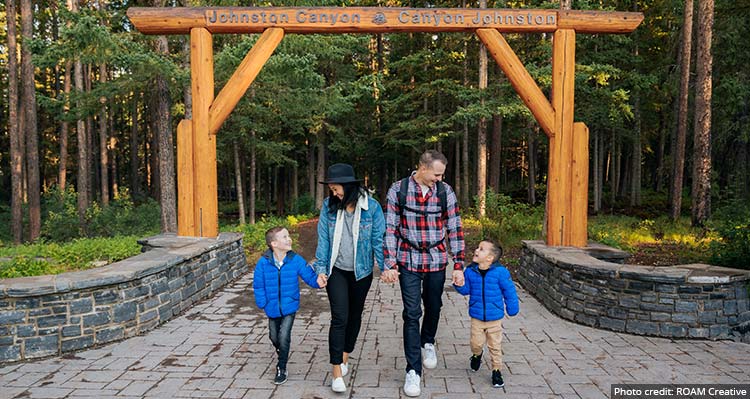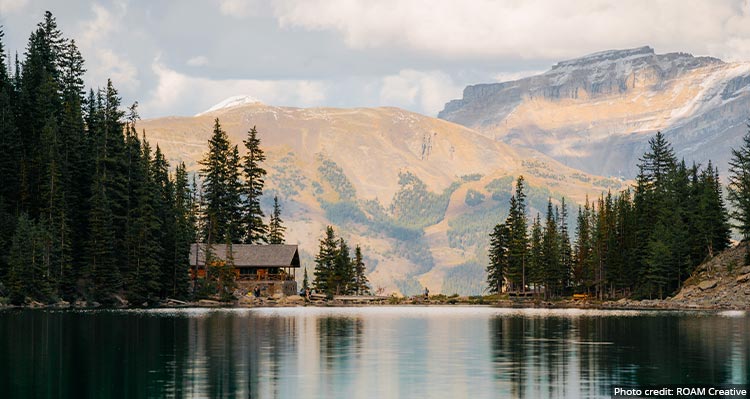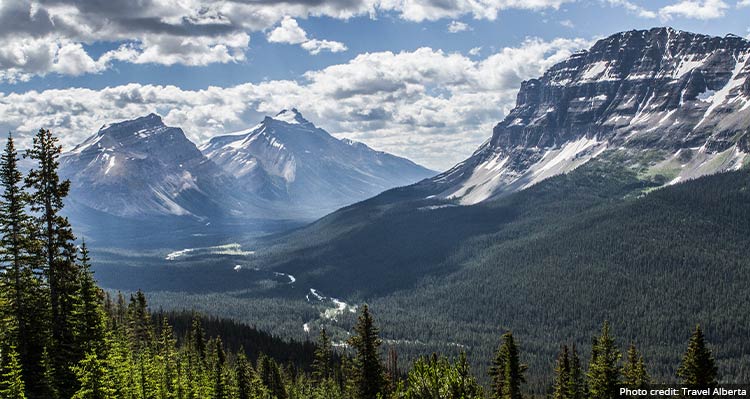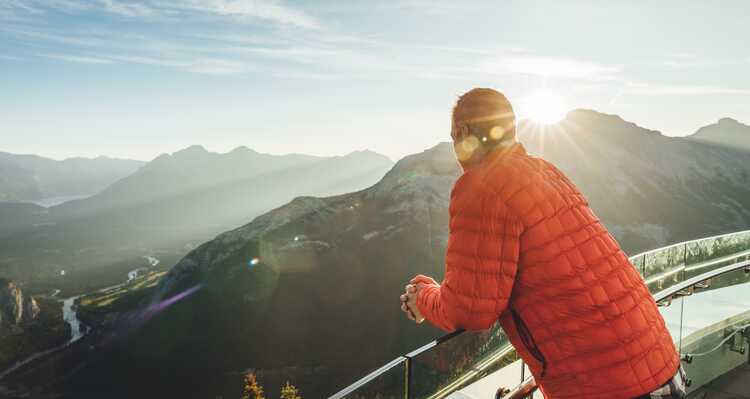Whether you’re summiting a mountain, visiting an alpine lake or passing through stunning valleys, there’s no place in the world for hiking quite like Banff National Park.
But how do you know what trail to hit? Our local team members have spent days, months, years and even decades in the Canadian Rockies — and they’ve hand selected their favourite hikes, including well known and less explored trails, for any skill level.
Stats: 5.5 km, 274 m elevation gain, 1–2 hours
There’s a reason Johnston Canyon is so well known among visitors and locals alike. This beginner-friendly hike offers a variety of views for less effort than other popular trails, which is why Reggie Lorenzo Casa, a line cook with Farm & Fire, loves it so much. “I’m a nature lover — especially waterfalls, mountains and trees,” Reggie explains. Expect to see the best of all three on this well-maintained, family-friendly trail.
If you get tired approaching the trail divide to the Upper Falls, you can skip it and opt for the easier Lower Falls. You can even book a local guide for a scenic evening hike, so you always know what animal, plant or tree you’ve just spotted.
Tip: Johnston Canyon can get very busy, especially during the summer months. Consider starting early to avoid big crowds and full parking lots or hop on Roam Transit Route 9.

Stats: 4.2 km, 216 m elevation gain, 1–2 hours
While this beginner trail might not take you up to the peak of a mountain, there’s still plenty to appreciate about less elevation gain. One such highlight is the alpine lake at the southern tip of the much larger Lake Minnewanka.
According to Banff Gondola barista Carrie Lin, the loop offers “stunning views of the lake.” This trail borders a campground, so don’t be surprised to find other folks enjoying the views and paddleboarders taking advantage of the calm waters. During the summer months, you might want to test it out yourself, so bring your swimsuit for a dip that’s sure to cool you off.
Tip: Parking near the trailhead is limited, so consider getting there early or taking Roam Transit Route 6. And after the hike, take advantage of proximity and book an adventure on Lake Minnewanka Cruise.
Stats: 7.4 km, 502 m elevation gain, 3–6 hours
A trip to Banff should include a visit to the iconic blue waters of Lake Louise, so why not do a hike while you’re there? Start by walking along the right side of the water and up into the mountains for a panoramic view from above.
On a warm summer day, you’ll be in the sun for much of the hike, so come prepared with sunscreen. Stacey Smith, guest experience supervisor with the Banff Gondola recommends “ending with a little treat at the teahouse” once you reach the top. Just bring cash to pay for your hard-earned snacks.
Tip: Feeling good at the top of the trail? Extend your adventure and continue along the Plain of Six Glaciers Trail (a total of 13.8 km and 591 m elevation gain).

Stats: 11.7 km, 550 m elevation gain, 4–5 hours
Located just about an hour outside of Banff townsite, the best part of this trail along the Icefields Parkway is that you get a little taste of everything. The hike includes “forest, alpine meadows, mountain lakes and long views down Dolomite Pass,” says Devon DaDalt, transportation general manager with Brewster Sightseeing.
Once again, the payoff for effort is well worth the journey to this trail. Plus, you might just spot some wildlife, as plenty of marmots make their home in the rocks nearby.
Tip: Make this your first stop on an adventure along the Icefields Parkway. Spend some time at Columbia Icefield Adventure, where you can traverse onto the Athabasca Glacier.

Stats: 7.4 km, 763 m elevation gain, 3–5 hours
Back towards Canmore, the Ha Ling Peak trail proves itself to be perfect for the hiker looking for a challenge. With such a steep elevation gain over less than 10 kilometres, it may come as no surprise that the final ascent is a scramble, so make sure to bring appropriate shoes and hiking poles for stability.
Regulars recommend coming prepared with lots of water and to keep in mind that the descent can sometimes be more challenging than the way up. “Go extra early so you can see the entire sunrise,” says Amélie Morency, food and beverage attendant with the Banff Gondola.
Tip: If you loved Ha Ling, then you’re a connoisseur of heights — which means your next stop should be the Banff Gondola. You can even enjoy a summit meal at Sky Bistro.

Stats: 10.5 km, 942 m elevation gain, 4–7 hours
If the rocky scramble of Ha Ling Peak doesn’t sound challenging enough, then Heart Mountain is the trail for you. Regular visitors recommend this trail only be attempted by experienced hikers and for good reason — parts of the trek involve light rock climbing.
Sophie Kinloch, food and beverage supervisor at Sky Bistro, recommends hiking the loop counterclockwise, but says she loves everything the trail has to offer, including “beautiful views, different peaks and a variety of terrain.”
Tip: You’re going to want a hearty dinner after this trail. Head back to Banff and directly into Brazen or Farm & Fire to refuel for the evening.
Before you embark on your next excursion into the mountains, remember these tips to keep yourself, animals and wildlife safe!
Don’t just come for one day — book your stay in Banff to make the most of your next mountain adventure.

About the author: Amber McLinden is a freelance writer and instructor at Mount Royal University in Calgary, Alberta. She can often be found hiking in the Rockies, planning her next vacation abroad or backcountry camping anywhere without cell service. You can read more of her musings at ambermclinden.com or in her weekly newsletter.
Insider tips, inspiration and deals — delivered straight to your inbox.